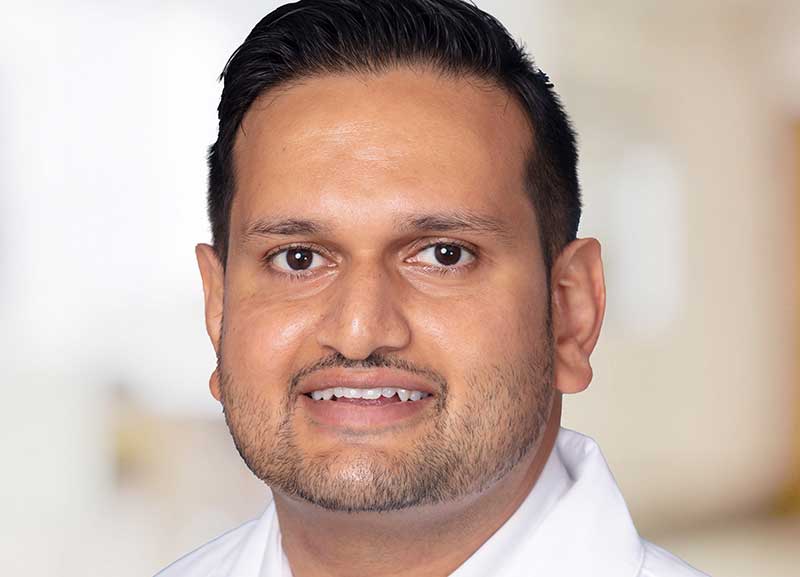By 2030, more than 12 million Americans will have AFib

Find “Putting Your Health First” wherever you listen to podcasts or visit HF.org/podcast.
CLICK HERE TO LISTEN to Cardiologist and Electrophysiologist Vishal Patel, MD discuss what AFib is, how its caught, and what can be done about it.
BREVARD COUNTY, FLORIDA – Of the irregular heartbeats that worry physicians, none is more common than atrial fibrillation – a condition characterized by a disorderly, frequently rapid heart rhythm – and the rates are rising. By 2030, more than 12 million Americans will have “AFib.”
Cardiologist and Electrophysiologist Vishal Patel, MD, jumped on Putting Your Health First, a podcast found on most popular platforms, to discuss what AFib is, how its caught, and what can be done about it.
In atrial fibrillation, the upper chambers of the heart – the atria – are given electrical signals necessary for contraction that are abnormal, often frenetic. Heart beats may rise unexpectedly to 250 beats per minute – even 300 or 400 bpm in extreme cases. It may lead to fatigue, lightheadedness, shortness of breath, chest pain, or any combination of these.
In addition to these momentary symptoms, AFib sufferers raise their risk of stroke because the blood rapidly pumped into the ventricles can’t be pushed out fast enough. Pooled blood begins to clot. These clots may get circulated to the brain, where they block arteries.
“When clots happen, they can shoot up and cause strokes, or can worsen kidney function,” Dr. Patel says. “So, atrial fibrillation as an arrhythmia is something that needs to be addressed.”
What Can Be Done
Ablation is an advanced procedure for treating atrial fibrillation, and Dr. Patel performs many at Health First’s Holmes Regional Medical Center’s Heart Center.
In an ablation, tiny, pinpoint burns or freezes produce a constellation of scarring inside the heart, preventing the muscle from responding to the electrical signals that cause irregular heartbeats.
There are several ablation modalities including pulsed field, radiofrequency or cryotherapy. The first is still investigational. Both radiofrequency ablation and cryoablation are effective treatment options for arrhythmias, including atrial fibrillation.
The choice between the two depends on various factors, including the specific arrhythmia being treated, the location of the abnormal electrical signals, and the preferences and expertise of the electrophysiologist performing the procedure. Dr Patel uses both radiofrequency and cryoablation to treat arrhythmias.
Unlike the first two, in cryoablation, a catheter traveling up to the heart from an entry point in the leg administers a targeted surge of cold energy that freezes the tissue, creating an electrical barrier that prevents arrythmias from spreading and disrupting the hearts normal rhythm.
Of course, in most cases, long before a cardiologist would schedule an ablation, a patient would be treated with medicines to control their heart rhythm and rate, and depending on age and risk, blood-thinning medicines to prevent blood clots leading to stroke.
About 1 in 5 strokes is caused by blood clots brought on by AFib.
Warning Signs
Dr. Patel is often asked what leads to atrial fibrillation, and he likes to joke – “birthdays.” The more birthdays, the higher the likelihood of developing AFib.
In fact, some arrhythmias go unnoticed. Silent AFib “is possibly the worst kind,” he says, “because if you have other risk factors such as heart failure, high blood pressure, history of a stent procedure … then some patients can end up having a stroke.”
CLICK HERE TO LISTEN to Cardiologist and Electrophysiologist Vishal Patel, MD discuss what AFib is, how its caught, and what can be done about it.
In truth, the exact root cause of AFib goes largely unknown, but some lifestyle factors raise the risk for developing it:
■ Advanced age
■ High blood pressure
■ Obesity
■ European ancestry
■ Diabetes
■ Heart failure
■ Ischemic heart disease
■ Overactive thyroid
■ Kidney disease
■ Smoking
■ Moderate or heavy alcohol consumption
■ Enlarged chambers on the left side of the heart
“At Health First, we have a collaborative approach – myself, our cardiologists who treat heart failure, as well as the cardiothoracic surgeons – we can in select patients offer them combined ablation procedures we call convergence.”
In these, ablations of the epicardium are performed concurrently with ablations inside the heart by way of endovascular catheters.
“And we’ve had good success,” but in any case, “I would urge patients to look around for treatment options and not ignore atrial fibrillation.”
See the QR code below to listen to the full podcast. Hear what Dr. Patel has to say about heartrate-monitoring consumer technology such as Apple Watch and Fitbit.
Stay up to date with Health First news and events at HF.org/news-events.
The post Putting Your Health First Podcast: Dr. Vishal Patel Says Don’t Live With AFib, Treatment is Available, Effective appeared first on Space Coast Daily.
